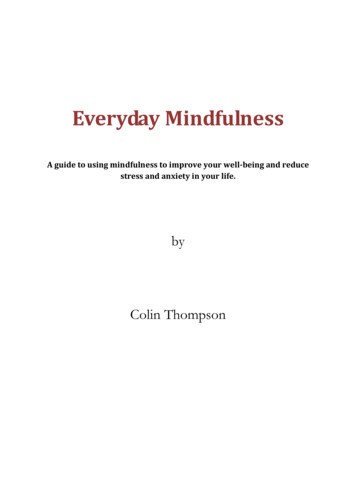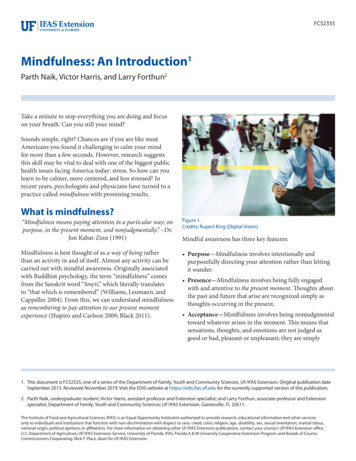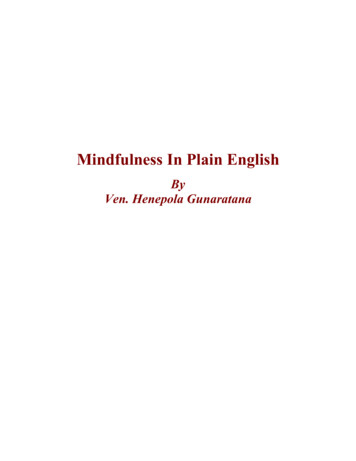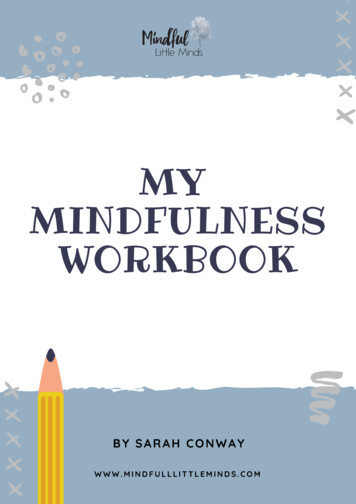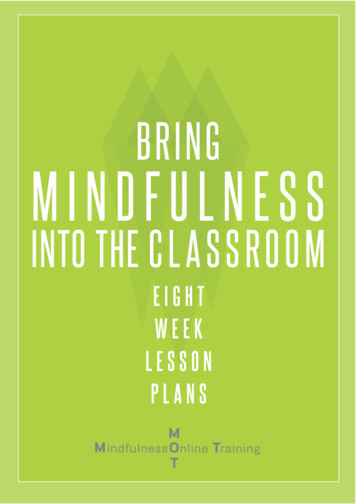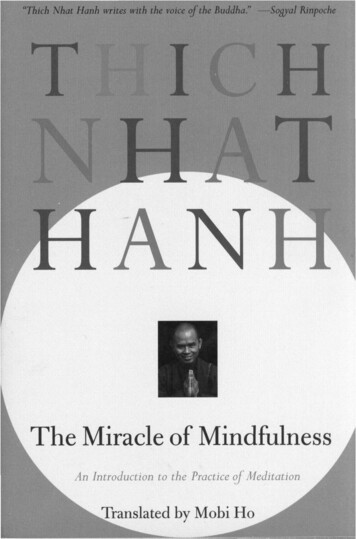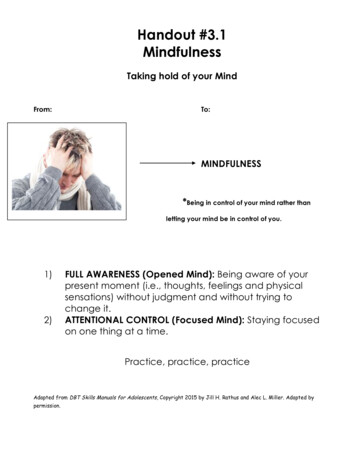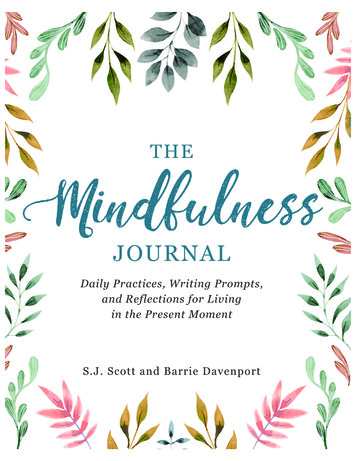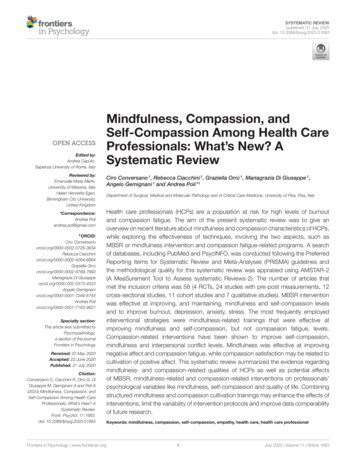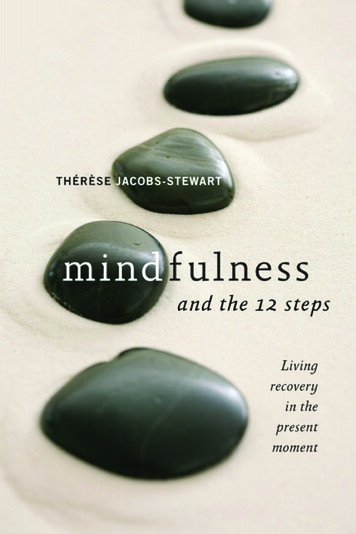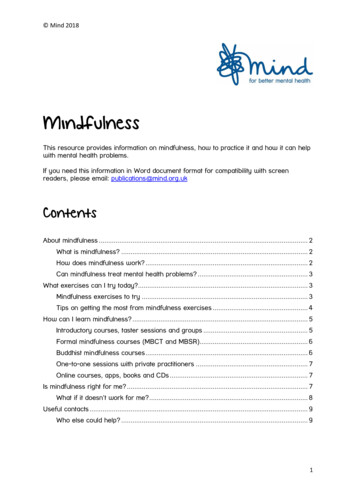
Transcription
Mind 2018MindfulnessThis resource provides information on mindfulness, how to practice it and how it can helpwith mental health problems.If you need this information in Word document format for compatibility with screenreaders, please email: publications@mind.org.ukContentsAbout mindfulness . 2What is mindfulness? . 2How does mindfulness work? . 2Can mindfulness treat mental health problems? . 3What exercises can I try today?. 3Mindfulness exercises to try . 3Tips on getting the most from mindfulness exercises . 4How can I learn mindfulness? . 5Introductory courses, taster sessions and groups . 5Formal mindfulness courses (MBCT and MBSR) . 6Buddhist mindfulness courses . 6One-to-one sessions with private practitioners . 7Online courses, apps, books and CDs . 7Is mindfulness right for me? . 7What if it doesn’t work for me? . 8Useful contacts . 9Who else could help? . 91
Mind 2018About mindfulnessWhat is mindfulness?Mindfulness is a technique you can learn which involves making a special effort to noticewhat's happening in the present moment (in your mind, body and surroundings) – withoutjudging anything. It has roots in Buddhism and meditation, but you don't have to bespiritual, or have any particular beliefs, to try it.It aims to help you: become more self-awarefeel calmer and less stressedfeel more able to choose how to respond to your thoughts and feelingscope with difficult or unhelpful thoughtsbe kinder towards yourself.Many people find practising mindfulness helps them manage their day-to-day wellbeing,but it doesn't always work for everyone (see our page on is mindfulness right for me?)Mindfulness is a skill. It requires work like any therapy and practicelike any skill. It isn’t a shortcut and courses only set the scene, but Ifind it enjoyable and rewarding. Most of all I find it brings some peaceinto my life.How does mindfulness work?The way we think (and what we think about) can affect how we feel and act. Forexample, if you think or worry a lot about upsetting past or future events, you might oftenfeel sad or anxious.The theory behind mindfulness is that by using various techniques to bring your attentionto the present (usually focusing on your body and your breathing), you can: Notice how thoughts come and go in your mind. You may learn that they don't haveto define who you are, or your experience of the world, and you can let go ofthem. Notice what your body is telling you. For example, tension or anxiety can often befelt in your body (such as in a fast heartbeat, tense muscles or shallow breathing). Create space between you and your thoughts, so you can react more calmly.The Oxford Mindfulness Centre has more information about how mindfulness works.When I feel anxiety building, mindfulness helps me to keep calm bybecoming more in touch with the situation.2
Mind 2018Can mindfulness treat mental health problems? Common mental health problems. Studies show that practising mindfulness canhelp to manage depression, some anxiety problems and feelings of stress.Some structured mindfulness-based therapies have also been developed to treatthese problems more formally. In some cases these treatments are recommendedas evidence-based treatments by the National Institute of Health and ClinicalExcellence (NICE). Complex mental health problems. Research into whether mindfulness could helptreat more complex mental health conditions, such as psychosis and bipolardisorder, is still in the early stages. It's not clear yet how helpful mindfulness couldbe for managing these conditions – but you might find it works for you.NICE recommends against using mindfulness-based treatments for social anxiety asthere's some evidence that mindfulness might make your symptoms worse rather thanbetter. Talk to your doctor about what kinds of treatments might suit you best.Mindfulness does help me with my mental health issues. It's not thecure and it won't work every single time, but it has helped me toalleviate anxiety and depression by centring my thoughts.What exercises can I try today?Mindfulness exercises to tryHere are a few exercises you could try. You don't need any special equipment: Mindful eating. This involves paying attention to the taste, sight and textures ofwhat you eat. For example, when drinking a cup of tea or coffee you could focuson how hot and liquid it feels on your tongue, how sweet it tastes or watch thesteam that it gives off. Mindful moving, walking or running. Notice the feeling of your body moving. Youmight notice the breeze against your skin, the feeling of your feet or hands againstdifferent textures on the ground or nearby surfaces, and the different smells thatare around you. Body scan. This is where you move your attention slowly through different parts ofthe body, starting from the top of your head moving all the way down to the end ofyour toes. You could focus on feelings of warmth, tension, tingling or relaxation ofdifferent parts of your body. Mindful colouring and drawing. Focus on the colours and the sensation of yourpencil against the paper, rather than trying to draw something in particular. You3
Mind 2018could use a mindfulness colouring book or download mindfulness colouringimages. Mindful meditation. This involves sitting quietly and focusing on your breathing,your thoughts, sensations in your body and the things you can hear around you.Try to bring you focus back to the present if your mind starts to wander. Manypeople also find that yoga helps them to concentrate on their breathing and focuson the present moment. See our page on types of alternative and complementarytherapy for more information meditation and yoga.Different things work for different people, so if you don’t find one exercise useful, tryanother. You can also try adapting them so that they suit you and are easier to fit in withyour daily life.You can find more examples of exercises to try in our page on relaxation exercises.Some people find practising mindfulness in nature can have extra benefits – see our pageof ideas to try in nature for suggestions.The mindfulness colouring really helps me unwind and relax in theevening. It promotes better sleep and I go to bed feeling ready to restrather than anxious and wired.Tips on getting the most from mindfulness exercisesWhen you do any mindfulness exercise, the key steps are: Pay attention – for example, when you shower in the morning, make a specialeffort to really pay attention to the feel of the water on your skin. Notice – when your mind wanders, which is just what minds do, simply noticewhere your thoughts have drifted to. Choose and return – choose to bring your attention back to the present moment,usually by focusing on your breathing or another sensation in your body. Be aware and accept – notice and be aware of emotions you are feeling orsensations in your body. Try to observe and accept these feelings with friendlycuriosity and without judgement. Be kind to yourself – remember that mindfulness is difficult to do and our mindswill always wander. Try not to be critical of yourself. When you notice your mindwandering, you can just gently bring yourself back to the exercise.It can also help to: Set aside regular time to practise. Regular short periods of mindful meditation canwork better than occasional long ones. If you struggle to find the time, you mightwant to decide on one or two routine activities which you will try to do mindfullyeach day.4
Mind 2018 Make yourself comfortable. It can help to do mindfulness in a space where you feelsafe and comfortable and won't be easily distracted. Go slowly. Try to build your practice slowly. Remember, you’re learning a newskill so it’ll take time to develop. Most people find it hard to sit and meditate forlong periods of time at first, so try to do a few minutes and gradually build up tomore. Be patient. There's no need to set ambitious goals or put pressure on yourself.Many people find it takes a while to feel comfortable doing mindfulness exercises.Mindfulness makes me feel safe because even when I can't access mycounsellors, carers, medication and relapse prevention plan,mindfulness is still there. Nothing can take it away.How can I learn mindfulness?This page gives an overview of the following options, and lets you know where to find outmore about them: Introductory courses, taster sessions and groupsFormal mindfulness courses (MBCT and MBSR)Buddhist mindfulness coursesOne-to-one sessions with private practitionersOnline courses, apps, books and CDsOur information on deciding whether mindfulness is right for you and getting the mostfrom mindfulness also suggests some useful things to bear in mind.Check your mindfulness teacher's qualificationsMindfulness courses should always be delivered by an appropriate person. Check yourteacher is listed by the UK Mindfulness Network. This shows that they are properlytrained, hold insurance and are supervised by another experienced professional.Sometimes mindfulness makes you turn towards things you wouldnormally avoid. That can be challenging. But if you have anexperienced mindfulness teacher they can help you to pace yourself.Introductory courses, taster sessions and groups'Introduction to mindfulness' courses: can range from one day courses to eight week coursesare typically very structured and will go through the basic concepts and exercisesmay be tailored to particular groups, such as students, people serving in themilitary or people with a particular diagnosis.Brief taster sessions and informal mindfulness groups are also common.5
Mind 2018You might find introductory courses, taster sessions or groups are organised throughyour place of work or education, or a local library or community centre. Some local Mindbranches may run mindfulness courses and groups. Private practitioners may also offerintroductory courses for a fee.I went on a mindfulness course once a week for about eight weeks. Itcovered body mindfulness, mindful eating, mindful walking, mindfulenvironmental awareness and more.Formal mindfulness courses (MBCT and MBSR)Some structured mindfulness therapy programmes have been developed to treat specificproblems. The most well-established courses are: Mindfulness-based cognitive therapy (MBCT) – for depression and anxiety.Mindfulness-based stress reduction (MBSR) – for general stress. It can also helpyou manage long-term health conditions.In some cases these are recommended treatments on the NHS, as studies show that theycan work well. But their availability on the NHS varies across the country, and waitinglists can be long. Different courses may have slightly different structures, but in generalthey: are delivered by qualified practitionerslast for a fixed number of sessions, across a specific time frame (typically weeklytwo-hour sessions run over eight weeks) – although some courses may offerintroductory sessions which are much shorter.are group-based, involving group work and group discussion (you can usuallycontribute as much as you feel comfortable with)involve a mixture of meditation daily mindfulness exercises, which you're asked topractise in between sessions.Talk to your GP or use the online NHS service finder to find out if these programmes areavailable near you. They may also be offered through the private sector, although thisinvolves paying a fee.You can also find out more from our pages on cognitive behavioural therapy(CBT) and talking therapy and counselling, and the MBCT website.Buddhist mindfulness coursesThese kinds of courses include traditional Buddhist practices of mindfulness meditationand other mindful techniques. They're usually taught at Buddhist centres in the context ofBuddhist teaching, and are likely to promote general mental wellbeing (not be a tailoredtreatment for specific health problems).See Buddhanet's world Buddhist directory to find a Buddhist centre near you, and contactthem directly to see what they offer.6
Mind 2018One-to-one sessions with private practitionersSome mindfulness teachers offer one-to-one sessions through the private sector. Sometherapists and counsellors also have mindfulness training and can integrate mindfulnessbased techniques into their approach. One-to-one sessions are more likely to be betailored to your particular situation, and don't include any group work, but they may beexpensive.You can look for a qualified mindfulness teacher or therapist in your local area through: The UK Mindfulness Network and Be Mindful online search tools, which only listqualified teachers.One of the professional bodies for therapy
Mindfulness-based stress reduction (MBSR) – for general stress. It can also help you manage long-term health conditions. In some cases these are recommended treatments on the NHS, as studies show that they can work well. But their availability on the NHS varies across the country, and waiting lists can be long. Different courses may have slightly different structures, but in general they .
